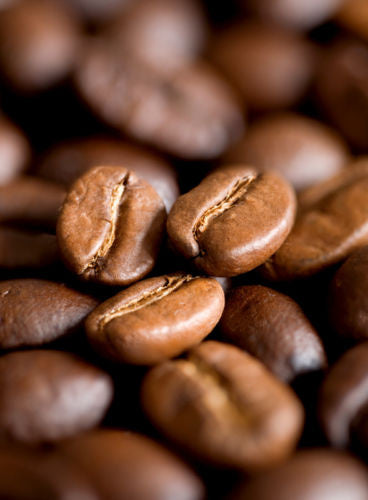For those of you who are interested in learning more about how we prune our coffee trees at Heavenly, this article is for you. I asked Ray to explain a bit more about this new pruning method to me. A quick, ten minute interview chalked it all up. He was quite generous with his information, so I figured I should share all I have learned from Mr. Taggart about it.
Saddle up, it's quite a ride.
The Beaumont - Fukunaga Vertical Pruning Method (pronounced boh-mont f-oo-k-oo-n-AA-g-uh) was developed in the early 1950's at the University of Hawai'i, Manoa. Two agricultural scientists were researching more efficient and effective ways of pruning coffee trees. Their intention was not only to help encourage new and fuller growth for the coffee trees, but also to aid with the amount of labor needed to take care of the crop. Hard, quality workers had become difficult to find; coffee trees require intense work and depth of knowledge is needed to properly care for them. With there still being over one thousand coffee farms located in Kona, Hawaii, alone, this research had the potential to be ground-breaking if these scientists did it right. As it turns out, they did.
For generations, the Traditional Kona Style Pruning Method has passed through the hands of families on Kona's coast. It defines true, hard and honest work, yet some say it is unnecessarily intensive in many ways. Topping the charts: the issue of needing to stop and observe each and every single tree in the plot annually, by a specially trained laborer or farmer to make the proper pruning selection.
Their skilled eyes would choose the new 'sucker' or 'shoot' that would be allowed to grow for the next four years on that particular tree. Understanding how to visualize possible issues specific tree branches might face as they grow, means comprehending which ones are going to be susceptible to breaking, disease and their availability to sunlight. The goal of the Traditional Kona Style Pruning Method was to remove all but one of these 'faulty' sprouts from each tree to make room for new growth. They would then remove the oldest branch from the tree to make space for the new shoot to grow. Every tree would have three or four main branches, each at a different stage of development, in a never ending cycle to maintain production. Visiting each tree, every year to produce this end result was something that proved to be time consuming and particularly laborious. If done wrong it could have the opposite effect and reduce production for years.

A young coffee tree exhibiting new, green shoots, or 'suckers. These are some parts of the plant that get removed during pruning and suckering. The bigger pieces that get removed need to be done with a saw, or by hand during pruning; the result is pictured.
The Beaumont - Fukunaga Vertical Pruning System was directly based on this opportunity for efficiency. Instead of needing to remove one quarter of each tree during pruning season, the Beaumont - Fukunaga method carries the same percentage of removal in the field and shifts it to the entire farm.
This means one quarter of the field accounts for all the pruning: trees are to be stripped of all growth entirely, excepting one branch or shoot. Essentially resetting the entire tree and enabling it grow from new again. Leaving the rest of the trees to grow until the next year, when a new quarter of the field will be chopped and allowing the trees that have been pruned, to focus only on growing shoots for the first year. Data has proven this method to produce tree shoots thicker, healthier and quicker. After three years, the maturity level of the coffee tree has more or less, peaked. Thus, further allowing them to focus only on growing as much coffee cherry as they possibly can. At four years, those new shoots will be producing massive amounts of coffee cherry.
Ray's example is this: It's like trying to read four books at once, or trying to read four books, one at a time.
For many, it would be easier to do the same thing over and over again, rather than trying to do many things at once. Especially when those different things require separate skill sets, equipment, and so forth.

A coffee tree in one of Heavenly Hawaiian's sectioned plots, several months after exercising the Beaumont - Fukunaga Pruning Method. Coffee is a hearty plant that has little to no issue growing back from the full prune. Most plants and trees will only be able to grow back with one third of the plant being removed. Adaptation is easy for coffee trees. It is a unique plant that has adapted incredibly well to the environment here in Hawaii.
Properly executed, this new method has shown a drastic reduction on the impact of labor by seventy-five percent in comparison to the Traditional Kona Style method of pruning. This is because a farmer, or laborer, would only need to visit a quarter of the trees in the plot, rather than every single tree during pruning season. Not only did the Beaumont - Fukunaga Pruning Method prove to be less time consuming, it also allowed the availability for anybody to follow it, rather than just trained professionals.

Originally, the Beaumont - Fukunaga Method was called 'stumping' because they would usually cut everything off of the tree, down to the stump. Over time, data found that around 5% - 10% of coffee trees would die off, requiring a new tree to be planted. Some farmers say that number can be less than 1% if they are fertilized and properly cared for. Now, to combat the death toll for coffee trees, we leave a 'nurse vertical' to ensure they can stay alive, healthy and continue to photosynthesize to produce more shoots.
Labor reduction was, and still is, especially necessary in Hawaii because the turnover rate for hiring individuals is usually quite high. Many folks are not able to stay long-term as laborers, so reducing the amount of labor has helped almost everybody, especially the small farms. Cutting necessary labor means being able to spend more time fertilizing, spraying and maintaining the field.
Coincidentally, mowing, weed-whacking and fertilizing coffee trees in these blocks are now easier. Spraying is generally unnecessary in these areas, which helps cut some costs too. For example, BotaniGard is the most expensive element used in our spray. It is a naturally produced fungus that takes care of the coffee berry borer, so it is absolutely necessary, however when using this new method, less is needed. Therefore, the price of it can be reduced by a quarter. Pickers have a certain quarter of the farm less to pick, while the farm itself continues to make the expected amount of coffee cherry throughout the rest of the trees, so farmers aren't really losing cherry.
As more folks began adopting this new method, many ways of achieving twenty-five percent reduction were found. Many small farms would prune every fourth tree, some people would go every fourth row. Here at Heavenly Hawaiian, our acreages are broken up into sections or blocks. For each section, Ray then specifically selects a quarter of the trees which creates our twenty-five percent.
Time has passed and the trees have grown exponentially - moving the farmers to top the trees. This prevents adding new growth, focusing the tree solely on producing coffee cherry. Data speaks for itself when it shows a ten to twenty-five percent increase in coffee cherry using the Beaumont - Fukunaga Method properly, in comparison to the Traditional Kona Style.

Green coffee cherries found on a healthy coffee tree among those pruned and suckered for the season at Heavenly Hawaiian Farms.
There are still plenty of farmers in Kona who have not adopted this method. Usually these folks are smaller farm owners who are not interested in switching ways, and understandably so. Sticking to what they know and what has proven to work for generations is hard to argue against; making the switch for the pruning season can also be a gamble for many. The first couple years after switching to the Beaumont - Fukunaga Method from the Traditional Kona Style will show a drop in production for those trees. After those two years, the coffee cherry will increase exponentially, thus resulting in the benefit of the Fukunaga method. However, some farmers are unable to do without the production for those couple years.
In many other countries, they have adopted this new method and added 'hedging and topping' the trees with large pieces of machinery. Giant sawblades on things that look like lawnmowers cut and trim the trees as they drive between the rows of hundreds to thousands of acres of coffee trees. This is something we do not do at Heavenly Hawaiian Coffee Farms. It would result in difficult hand picking, and incredibly bushy coffee trees. These same farms that use the hedging and topping methods are typically using machines to shake their coffee cherry off the trees, which we also do not do at Heavenly. Mechanical harvesting tends to get more of the under-ripe cherry mixes in and can effect the flavor in the cup. It makes sense for us to use the new method of pruning without machinery. We are still a family owned business that focuses on hand-picking our coffee for the best possible flavor, staying viable and successful.
In short:
Annually, more and more farms, usually the larger ones, are changing to the Beaumont - Fukunaga method of pruning. The Traditional Kona Style pruning method is being held by many smaller farms dotted along the coast.
Kona style is taking off one branch, the most mature one, from every tree - think freshman to senior year. Twenty-five percent of each coffee tree is removed. and then selecting just one shoot to replace it.
The Beaumont - Fukunaga method is very similar, by using the same twenty-five percent removal process and amount of verticals (shoots). The removal can be found as a quarter of the entire field, rather than each tree. A few months later all but four shoots will be removed to create the crop for the next four years.
Both of them still require the need for suckering, which is removing the new, green shoots that will eventually turn into a hearty, brown shoot.








1 Comment
A very insightful article. Am encouraged to try it out on my farm in Kenya